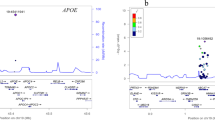Abstract
Tumor Necrosis Factor Receptor Super Family 6 gene (TNFRSF6), also known as FAS, encodes the Fas antigen, a cell surface receptor mediating cell apoptosis, situated on chromosome 10q located near the region of linkage to sporadic Alzheimer’s disease (sAD). FAS levels have been reported elevated in the brain of AD patients. Due to both positional and pathobiological criteria, the association of the FAS antigen with this pathology is of great interest. We have tested two SNPs in the FAS gene in 223 Italian patients with non-familial AD from Southern Italy (Calabria region) and 211 healthy control subjects. No significant differences in allelic and genotypic distributions were found between cases and controls, or late and early-onset AD patients, thus suggesting that these polymorphisms do not represent an AD risk factor in our population.
Similar content being viewed by others
References
Goate A, Chartier-Harlin MC, Mullan M, Brown J et al (1991) Segregation of a missense mutation in the amyloid precursor protein gene with familial Alzheimer’s disease. Nature 349(6311):704–706
Sherrington R, Rogaev EI, Liang Y et al (1995) Cloning of a gene bearing missense mutations in early-onset familial Alzheimer’s disease. Nature 375(6534):754–706
Levy-Lahad E, Wasco W, Poorkaj P et al (1995) Candidate gene for the chromosome 1 familial Alzheimer’s disease locus. Science 269(5226):973–977
Pericak-Vance MA, Haines JL (1995) Genetic susceptibility to Alzheimer disease. Trends Genet 11:504–508
Strittmatter WJ, Saunders AM, Schmechel D et al (1993) Apolipoprotein E: high-avidity binding to beta-amyloid and increased frequency of type 4 allele in late-onset familial Alzheimer disease. Proc Natl Acad Sci USA 90(5):1977–1981
Tanzi RE, Bertram L (2001) New frontiers in Alzheimer’s disease genetics. Neuron 32:181–184
Smale G, Nichols NR, Brady DR et al (1995) Evidence for apoptotic cell death in Alzheimer’s disease. Exp Neurol 133(2):225–230
Ashkenazi A, Dixit VM (1999) Apoptosis control by death and decoy receptors. Curr Opin Cell Biol 11(2):255–260
Martinez M, Fernandez-Vivancos E, Frank A et al (2000) Increased cerebrospinal fluid fas (Apo-1) levels in Alzheimer’s disease. Relationship with IL-6 concentrations. Brain Res 869(1–2):216–219
Nishimura T, Akiyama H, Yonehara S et al (1995) Fas antigen expression in brains of patients with Alzheimer-type dementia. Brain Res 695(2):137–145
Bertram L, Blacker D, Mullin K et al (2000) Evidence for genetic linkage of Alzheimer’s disease to chromosome 10q. Science 290(5500):2302–2303
Myers A, Holmans P, Marshall H et al (2000) Susceptibility locus for Alzheimer’s disease on chromosome 10. Science 290(5500):2304–2305
Feuk L, Prince JA, Breen G et al (2000) Apolipoprotein-E dependent role for the FAS receptor in early onset Alzheimer’s disease: finding of a positive association for a polymorphism in the TNFRSF6 gene. Hum Genet 107(4):391–396
Huang QR, Morris D, Manolios N (1997) Identification and characterization of polymorphisms in the promoter region of the human Apo-1/Fas (CD95) gene. Mol Immunol 34(8–9):577–582
Tsukada J, Waterman WR, Koyama Y et al (1996) A novel STAT-like factor mediates lipopolysaccharide, interleukin 1 (IL-1), and IL-6 signaling and recognizes a gamma interferon activation site-like element in the IL1B gene. Mol Cell Biol 16(5):2183–2194
Mc Khann G, Drachman D, Folstein M et al (1984) Clinical diagnosis of Alzheimer’s disease: report of the NINCDS-ADRDA Work Group under the auspices of Department of Health and Human Services Task Force on Alzheimer’s Disease. Neurology 34(7):939–944
Crum RM, Anthony JC, Bassett SS et al (1993) Population-based norms for the Mini-Mental State Examination by age and educational level. JAMA 269(18):2386–2391
Pericak-Vance MA, Bebout JL, Gaskell PC et al (1991) Linkage studies in familial Alzheimer disease: evidence for chromosome 19 linkage. Am J HumGenet 48(6):1034–1050
Chiappelli M, Nasi M, Cossarizza A et al (2006) Polymorphisms of fas gene: relationship with Alzheimer’s disease and cognitive decline. Dement Geriatr Cogn Disord 22(4):296–300
Huang QR, Danis V, Lassere M et al (1999) Evaluation of a new Apo-1/Fas promoter polymorphism in rheumatoid arthritis and systemic lupus erythematosus patients. Rheumatology 38(7):645–651
Lee YH, Kim YR, Ji JD et al (2001) Fas promoter -670 polymorphism is associated with development of anti-RNP antibodies in systemic lupus erythematosus. J Rheumatol 28(9):2008–2011
Cascino I, Ballerini C, Audino S et al (1998) Fas gene polymorphisms are not associated with systemic lupus erythematosus, multiple sclerosis and HIV infection. Dis Markers 13(4):221–225
Rosenmann H, Meiner Z, Kahana E et al (2004) The Fas promoter polymorphism at position -670 is not associated with late-onset sporadic Alzheimer’s disease. Dement Geriatr Cogn Disord 17(3):143–146
He XM, Zhang ZX, Zhang JW et al (2006) The Fas gene A-670G polymorphism is not associated with sporadic Alzheimer disease in a Chinese Han population. Brain Res 1082(1):192–195
Acknowledgment
The authors are grateful to the AD patients and their families, that have made this study possible. We also thank Dr. Laura Jean Carbonaro for the stylistic revision concerning English.
Author information
Authors and Affiliations
Corresponding author
Rights and permissions
About this article
Cite this article
Andreoli, V., Nicoletti, G., Romeo, N. et al. Fas Antigen and Sporadic Alzheimer’s Disease in Southern Italy: Evaluation of Two Polymorphisms in the TNFRSF6 Gene. Neurochem Res 32, 1445–1449 (2007). https://doi.org/10.1007/s11064-007-9329-6
Received:
Accepted:
Published:
Issue Date:
DOI: https://doi.org/10.1007/s11064-007-9329-6




